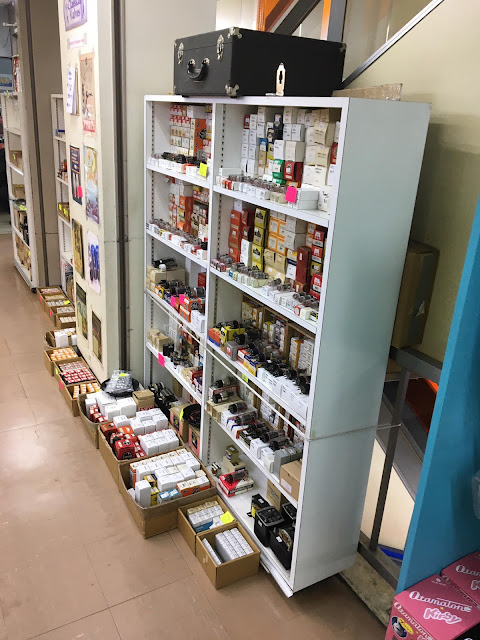 |
Front: Shure M3D
L > R: Pickering 380, Stanton 371, Empire 888, Shure M7D |
In the early 2000s, I spoke highly of the Shure M3D and M7D in
retro cool tonearms and cartridges. Being an inveterate collector, I've acquired a couple more early stereo phono cartridges that came with turntables and tonearms I purchased in the ensuing years. I'm revisiting the two Shures in this long overdue follow-up and will compare them to a few more cartridges from the dawn of the stereo LP era.
The cartridges were evaluated in my
main system and also in
my audio playground. Turntables used include the Garrard 401, Gates CB77 and Sony TTS2500, fitted with the Audio Technica 1501-II, Fidelity Research FR64fx, FR54 and Grace G565 tonearms.
Shure M3D and M7D
 |
| Shure M3D |
These two models were engineered from the same blueprint. While the M3D was manufactured to closer tolerances, the less stringently built M7D was marketed towards budget-conscious listeners. If forced to split hairs, I'll admit to hearing more refinement, better stereo separation, slightly better resolution and extension in the frequency extremes from the M3D. But in all honesty, I'd much rather enjoy their music-making abilities.
 |
| Shure M7D |
The key attribute of this cartridge design (which
sadly Shure veered away from until they completely exited cartridge manufacturing in 2018) is its lifelike presentation of the midrange. I stand by my earlier assessment that these are the moving magnet equivalents of the
Ortofon SPU.
Empire 888
I'm not sure if the stylus in this cartridge body is an OEM or a generic replacement. But I deemed it was fair enough to include it in this survey since it tracked like a champ at a moderate 2 grams of Vertical Tracking Force (VTF) and subjectively, it offered a very smooth and probably the most extended treble response in this group. Even if this cartridge seems to already be shying away from a tonal balance that emphasizes the midrange, the tinge of midrange warmth was still most welcome!
 |
| Empire 888 |
Bass quality is very much in keeping with the overall character of this cartridge which is clean and well defined.
In spite of this cartridge's very refined character, it lacks dynamic contrasts especially at micro and macro levels. I find myself cranking the volume control up for it to boogie but I still end up wanting more. Resolution of detail is at par with others in this survey while the slow transient response across the audio band, keeps it behind the others in this survey.
Pickering/Stanton 371 and 380
Based on this ca.
1960 catalog pages, the 371 and 380 were marketed simultaneously by Pickering/Stanton. Despite both being Stereo Flux-valve (moving iron) designs, these stablemates sound diametrically opposed.
 |
Stanton 371 + gray mono LP stylus
see reader comment below |
Except for the 4 gram minimum VTF, I thought I found a cartridge from the dawn of the stereo era in the 371 that would appeal to 21st century standards of neutrality, transparency, detail and resolution. There was a striking presence and immediacy from this cartridge. However, as I went through my favorite LPs, I detected peakiness from the upper midrange to lower treble which gave that fake analytically transparent vibe. Soon the upper midrange glare became very fatiguing, especially with female vocals. Further listening also confirmed a rapid roll off in response above that peak, which prevents the listener from getting a true sense of air and space.
 |
Stanton 371 + red stereo stylus
see reader comment below |
A reader below called my attention to the fact that the gray stylus I used in my original evaluation was intended for mono LPs. So I ordered the red stylus from Gary at
V-M. However, the same tonal shape I noted above remains with slightly reduced glare and peakiness.
 |
| Pickering 380 |
My long time hamfest/radio show buddy,
Larry R. clued me in to the 380 after reading my
original article eons ago. This cartridge is not easy to set up due to its weird body shape. Fortunately, I had some threaded spacers and screws, which came with my Stanton 500. This facilitated installation on a modern IEC/SME type head-shell. Using an original red stylus tracking at 3.5 grams, this sounded warmer, smoother and sweeter than the M3D/M7D. The midrange is spacious, airy and the 3-dimensional presentation is quite beguiling, even more SPU-like! Mid to upper bass definition is at par with the two Shures. However, it rolls off earlier and doesn't possess as much heft and weight. In spite of its excellent handling of micro and macro dynamics, transient response is a tad slower.
Coda
The Pickering 380's 3-D midrange and refinement were definitely alluring. But if I were forced to choose between the 380 and the M3D/M7D, I'd sacrifice a bit of midrange refinement in favor of the better bass extension and dynamics offered by the two Shures. Although the Stanton 371 tried to leap far ahead of its time, to my ears, it had fatal flaws. On the other hand, the Empire 888 was forecasting what was to come, for better or worse.
On another note, I'm happy to report that even after 20 + years, not one stereo LP from my collection has been harmed by the 2.5 to 4 gram VTF 😱 by my favorite stereo cartridges! 😁



























































